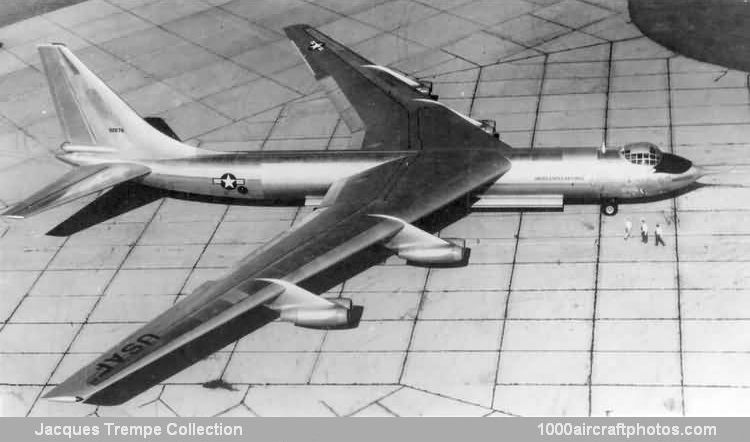06/30/2014. Remarks by Johan Visschedijk: "The Boeing B-52 Stratofortress has been one of the most successful and longest-serving of warplanes but when it was being developed in the early 1950s, the USAF wanted a back-up to guard against failure. Consolidated Vultee (Convair), the well-established builder of B-24 and B-36 bombers, offered what might have seemed formidable competition to the coming B-52, namely, a jet-powered variant of the B-36 which would make use of some 72% of the previous bomber's airframe.
Known at first as the YB-36G but quickly redesignated YB-60, this heavy bomber was subject of a March 1 order for two service-test prototypes, YB-60-1-CO (s/n 49-2676) and YB-60-5-CO (s/n 49-2684). The YB-60 was characterised by a huge new swept wing and tail. The aircraft was 175 ft 2 in (53.39 m) long and stood to a height of 60 ft 5 in (18.42 m), but its dominant feature was the 35° swept wing which spanned 206 ft 5 in (62.92 m) and had an area of 5.250 sq.ft (487.74 sq.m), about 30% greater than the wing area of the B-52).
The huge bomber was to be powered by eight Pratt & Whitney XJ57-P-3 turbojets, each developing some 11,200 lb (5,080 kg) thrust. The aircraft retained the 72,000 lb (32,659 kg) bomb-load of its predecessor but crew size was reduced from ten to five and armament was limited to two radar-guided 0.787 in (20 mm) cannons in the tail. A sort of hybrid, no longer a propeller-driven bomber but awkward and wrong looking for a jet, the first YB-60 (49-2676) thundered aloft at Fort Worth on April 18, 1952 (the second would never fly). Although the YB-60 had quite conventional tricycle landing gear, photos were initially released with this feature touched out, apparently because similar doctoring of pictures was intended to conceal the more unusual four-piece landing gear of the competing YB-52.
Boeing officials are known to have felt some concern about the YB-60 because of Convair's en-trenched position as a builder of long-range bombers and because congressmen from Texas tended to have more clout than those from Boeing's home state, Washington. There was never any anxiety on purely technical grounds. The YB-60 just didn't have it. Official figures list maximum speed as an unimpressive 508 mph (818 kmh) and combat radius as a mere 2,800 mls (4,506 km). In fact, the YB-60 would have been 'meat on the table' for the Soviet MiG-15/17 interceptors of the period. A behemoth if not a beauty, the YB-60 weighed about 150,000 lb (68,000 kg) when empty and had a maximum all-up weight of over 410,000 lb (186,000 kg). It reputedly would stall at 140 mph (225 kmh).
A scant seven months after the bomber's first flight, the USAF announced on December 16, 1952 that the YB-52 had won the competition between the two types. In truth, there was never a real competition at all. The two YB-60s were grounded at Fort Worth and survived for a number of years before being scrapped, but they had never really been in the running. Convair could be rightly proud of its reputation as a builder of other bombers, and the firm would later produce the superb B-58 Hustler, but the YB-60 was simply an idea whose time never arrived."
